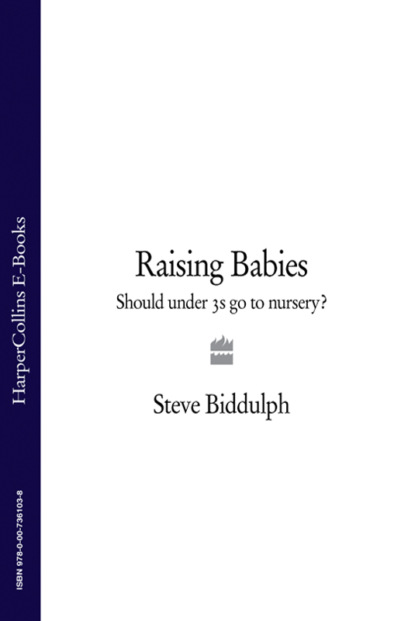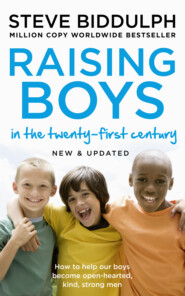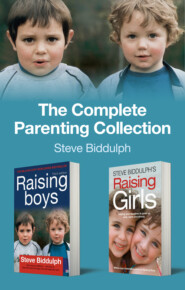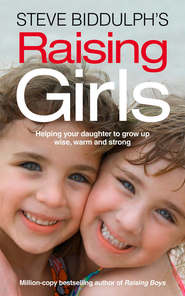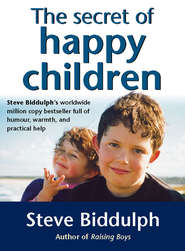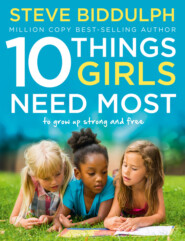По всем вопросам обращайтесь на: info@litportal.ru
(©) 2003-2024.
✖
Raising Babies: Should under 3s go to nursery?
Автор
Год написания книги
2019
Настройки чтения
Размер шрифта
Высота строк
Поля
At first, I was afraid to release this book. Five years ago when I began writing, its message seemed so confronting, so against the tide. So I discussed it with hundreds of people – nursery directors and staff, psychologists, psychiatrists, parents, grandparents, academics, researchers. All of them gave me the same feedback – that ‘someone had to speak up’, that the message was ‘urgently needed and long overdue’.
Helping you decide
It’s likely you have come to this book with a specific aim: to try and decide whether your baby or toddler should spend time in a nursery or daycare centre. In the chapters that follow I will clearly lay out for you the best current information about just this. I will also explore what choices other parents are making and why. Stories of nursery care, and stories of real life families working out what to do will help you clarify your own priorities.
There has been much soul-searching about whether nursery care is a good idea, and also much widely-conflicting information. The ‘daycare debate’ has received more media coverage, and more concerted research by child development experts, than any other aspect of childrearing in the last 30 years. For a while the results were uncertain, but recently this situation has changed. New results from wide ranging and very large-scale studies have emerged that clarify the dangers, and explain why nursery care is far from what we might want for our children.
(#litres_trial_promo)
(#litres_trial_promo) These results, and the dramatic story of how they were uncovered, make up the core of this book. Once and for all these findings can clear up the question that parents most want answers to: ‘Will nursery care harm my child?’
The answer, as you might suspect, is ‘yes’, often it will. But not always – under certain conditions, and when children have reached the right age, nurseries or, better still, pre-school education can be a plus. I will detail for you what these conditions and ages are.
The results may be alarming to some, but seem perfectly obvious to others. Finally, we are waking up to the fact that something is amiss in the way we rear our children, and this includes our glib assumption that group care in nurseries is probably okay.
To further help you make your mind up, I will explain the latest understanding of how a baby’s brain develops, wonderful new discoveries about how they learn to love and think, and feel calm and resilient in the world. You can then appreciate the part that a loving parent can play, and how hard it is for people who are not close to your child to provide this.
In the last ten years, researchers have learned that a baby’s brain grows whole new structures in response to the love and affection, and caring firmness, given during its first two years of life.
(#litres_trial_promo) If this kind of intense love is not given at the right time, these areas of the brain do not grow properly and, as a result, there are abilities a child may never acquire. This is perhaps the most vital message of this book – children raised without sufficient loving care do not become fully the human beings they were meant to be.
This is shocking news, and it has jolted governments around the world to consider giving more attention to the needs of young families. It confirms what most of us have always felt deep down – that loving, patient and supported time with young babies is not a luxury, but a vital nutrient that we must provide. My hope is that this knowledge will strengthen you to follow your heart, and not the dictates of advertisers, governments, employers or other social forces around you. By the end of this book you will be well equipped to make the best decisions for your baby or toddler, to know why you are making these decisions, and to feel a real peace and strength that you are doing what is right.
Raising Babies aims to provide you with the resources for your own reflection and deeper thought. It not only involves you becoming as informed as possible but also sharpening your own perceptions and, in the end, listening to your own heart. The aim is not to tell you what to do, but to awaken your own sense of what you really want out of your life. This may set you at odds with the direction of the society around you, but as history has shown, that can often be a good thing.
This book won’t change anyone’s mind who doesn’t want to hear its message, but it will give strength to those parents whose hearts have been troubled, and who feel something is wrong; who want their family life to be gentler, more happy and more loving than what has become the norm. To these parents, let me say – your heart is right, and you can find a better way. All my good wishes go with you.
Steve Bidd
In a nutshell
My friend’s experience alerts me to the fact that the childcare choice is often made under pressure, and many young parents do not realize just where their true feelings lie until they have to part with their child.
Society has become more materialistic and has fatally neglected the place of caring, community and family needs in our lives.
Governments have failed to protect families from corporate pressures and many people can no longer afford to care for their own children.
Quality nursery care appropriate to very young children does not exist. It is a fantasy of the glossy magazines.
If your heart has been uneasy about these things, it is probably right. You CAN find a better way.
Part One The Truth about Nurseries (#ulink_cef4c071-7f24-5446-a764-ceb5c073a95c)
What are nurseries really like?
Are they good for children under three?
What are other parents choosing – and why?
What does the research say?
How can I make the best life choices that won’t harm my child?
1 What nursery is like (#ulink_5a1f381b-6a40-5a63-b359-9129fa0ccefe)
Becoming a parent for the first time is an unbelievable feeling. It is an intensely happy time, and yet frightening too. Having this tiny baby in your home, in your arms, you feel terribly responsible and want to give your child the best care that you can. As it dawns on you how utterly dependent a human baby really is, you can easily feel overwhelmed by its needs and demands. Gradually, through the struggles, the sleep deprivation, the altered sense of time, the totally rearranged priorities, you and your child find a rhythm, and you discover you really can do it. You begin to live a very different, subtler, deeper kind of life.
And then you are faced with the decision, like an impending grief – to return to work or stay at home? People are urging you in different directions, but what do you want to do? The first thing is to realize that you really do have a choice. You may be surprised to learn what other people choose. Despite all the financial pressures, and the general feeling that both parents should be in the workforce, from government and employers, over 40 per cent of all UK parents choose that one of them will stay home until their children are of school age. (And these are surprisingly often people who choose to make financial sacrifices, and are not especially well off. Wealthier people have a long tradition of farming out their childcare, which continues to this day.) Of the rest, most ‘primary caregivers’ (by which researchers usually mean mothers) return gradually to part-time work, usually only after their child reaches two or three, and perhaps full-time work as their children get older and better able to cope with out-of-home care. (In around 5 per cent of families, the father stays at home, and the mother returns to full-time work at some time during the first five years.) And finally, it might surprise you to learn that only about 1 in 20 families put their baby straight into full-time, ten-hours-a-day nursery care before the baby is one year old. We will look at these choices and their pros and cons later in the book. For now the main point is – you do have a choice.
To choose wisely you must be informed; so the most important thing you must do, before committing yourself to any long-term plans, is go and find out what a nursery is really like. Forget the brochures, the glowing propaganda, and the cheery reassurances of those who want to persuade themselves that all is fine. For a decision this big you have to see for yourself. Not just a flying visit, or the official guided tour – ‘look at the little toilets, aren’t they cute?’ – but an hour or more of melting into the background, quietly observing what goes on. It is a good idea to go alone the first time (without your baby), then you can ask to go back with your partner for a second look at a different time on a different day. The aim is to get an accurate sense of what it might be like to be a child spending ten hours a day in such a place.
Trusting your senses
As you enter the nursery’s doors, the feeling and mood of the place will be immediately obvious. In fact it is something of a sensory overload. Here are some of the impressions you might form.
1 The lack of peace
There is something exhausting and overwhelming about so many small people in one confined space. It is noisy, even when the sounds are all happy, but add a certain amount of crying or angry shouts, and it is a stressful sound, which – apart from at ‘nap time’ (and that is rarely silent) – continues all day long.
Apart from the noise, there is a difficulty in keeping mental focus. Children at this age are capable of concentrated quiet play – imaginary games, chatting to themselves, being peaceful. But in this environment, it is not easy for them to settle: they run about, fight over toys, compete for adult attention. Carers share themselves as best they can, prevent fights, try to engage quiet or shy children, stimulate play activities, but there is often a feeling of jumble and coping, rather than enjoyment and peaceful concentration.
2 The sense of vulnerability
Childhood is an aggressive time – even at home, little children often resort to hitting, pulling, shouting, as they lack the skills to sort out conflict in better ways. But in a large group setting it gets worse. Groups of bigger boys, or meaner girls who physically or emotionally dominate things, can be a problem if your child is quieter or less assertive. Alternatively your child may become one of the dominators or bullies, as another way of dealing with the stressful environment. Under-twos are too young to nurture or befriend each other for more than a few seconds, or even play together co-operatively. Problems soon arise. A carer will usually intervene to protect the weaker children, but not always in time. It is only bumps and biffs and unkind words – they won’t end up in hospital – but it is emotionally unsettling and scary to quite a few children. And there is no escaping it. Your child will be confined with the other children all together, all day long.
3 The lack of homeliness or a place of one’s own
While there are interesting toys, play equipment and adults to encourage your child, there is no personal space; no quiet corner or toy or piece of furniture that is his or her own, apart from a coat hook and perhaps a piece of artwork taped on the wall. A child is rootless and unanchored, moving from one spot to another.
The baby room
‘I went to a very nice, very expensive, highly-recommended nursery when I was nine months pregnant, in preparation for my return to work when my child was seven months old. I will never forget the feeling I got when I walked into the baby room. There were nine babies and three carers. One baby was being fed, one was having its nappy changed, and one other was being comforted as it was crying. The other six were sitting around in baby chairs in varying states of apathy and boredom. All I could think of was “these babies have been abandoned”, and I wanted very strongly to cry.’
(website contributor, March 2006)
4 There are never enough adults to go around
Ratios of staff to children are always a compromise compared with what would be ideal. Usually there is one staff person to three or four babies, and one carer to eight to ten toddlers or older children. The staff do their best to share themselves around, but it is non-stop all day. A study commissioned by the Department of Education in 1999 found that the average amount of 1:1 attention per child was only eight minutes per day.
(#litres_trial_promo) Staff respond to crises, divert problems, comfort a crying child, take someone to the toilet – and move on. Caring for so many children all day is difficult and draining – you will see the adults ‘zone out’ by taking mental breaks when they can, simply for self-preservation.
5 Some kids cope less well than others
You will notice some children having fun, showing mastery, and confidently talking to staff and claiming their attention. Others will hover on the edges, comfort themselves with repetitive movements, look warily about, or make forays into play and then retreat. They often seem detached, not quite there. They are far from happy, not showing any of the singing, laughing, chattering behaviour of the truly happy child. Yet to the staff these are ‘good’ children, not troublesome. They tend to be forgotten while more demanding kids take up the carers’ time.
Hanging on the gate
I’m visiting a high-quality nursery on an observational visit. Today the weather is mild, and a group of three-year-olds have been taken outside to play. I notice that one girl is not playing with the others. She is hanging onto the gate into the yard, pulling at it in a listless repetitive action. I check my watch, and keep watching for about 20 minutes, and in that time she never stops the tugging action, rocking her body, gazing about as she does so. The young male carer is busy with other children, and seems oblivious to her. But now something happens: a boy, also a bit of a loner, is making his way along the fence line banging a stick on the railings. He stops when he reaches her – an obstacle in his path. They look at each other; I am too far away to tell if they speak. I’d like to report a human moment, a bit of contact, but sadly it’s not to be. He solves the problem by making her not matter, he trails his stick across her middle, and continues on his way. She goes on pulling absently at the gate. The message of her body language seems so plain – ‘Let me out of here.’





